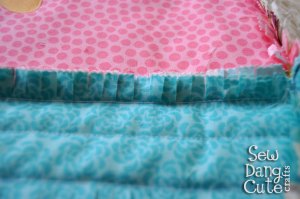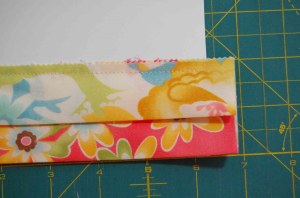![]()
It is a thrill to be back at the Bake Shop today. Nothing charms my geeky soul like designing a quilt and writing directions for it. Nothing comes close…except for memories of my Nanny. I grew up in a household that had room for the whole family. There was always room for one more. My maternal grandparents were a daily presence and made my life that much richer. I know in some homes, especially in the American South, Nanny would have been called Mimi, so my thought turned to her as I finished this quilt.
Nanny was English – naturalized as an American as a little girl – she never lost that lovely English way of doing things…nor the accent! Gosh I miss her. She would have loved this fabric line. I can imagine her sitting with me on top of this quilt playing board games, or snuggled under it on the front porch reading together. It isn’t a hard stretch at all, even 13 years after she celebrated her last birthday.
Spring time, little girls, grandmothers, it all combines to make a great song…sweet and homey. This quilt is the product of that song. I hope you like it.

- 1 layer cake
- I used Mimi by Chez Moi
- 1/3 yard for flower centers
- I used #16098-15 – yellow dots;
- 1 1/4 yards solid for background on 9 blocks (dominant background)
- I used Bella snow #9900-11
- 1/2 yard solid for background on 4 blocks (secondary background)
- I used 9900-169 ruby ice
- 1/3 yard for inner border
- I used #16098-19 – red dots
- 2 yards for setting triangles and outer border
- I used #16095-11 – flowers on cream and aqua
- 1/2 yard for binding
- I used #16098-22 – aqua dots
- 6 yards for backing
- I used #16094-13 lavender leaves

- From Layer Cake
- Cut 52, 5″x5″ squares (in sets of 4)
- select 13 slices for flower petals that will contrast with your background and your flower center fabric
- cut each slice into 4, 5″x 5″ squares for 52 squares
- From flower center fabric
- cut 13, 5″x 5″ squares
- cut 2, 5″ x width of fabric (wof) strips
- sub cut first strip into 8, 5″x 5″ squares
- sub cut second strip into 5, 5″x 5″ squares plus a remnant
- From dominant background fabric
- cut 36, 5″x 5″ squares
- cut 5, 5″ x wof strips
- sub cut 4 strips into 8, 5″x 5″ squares each for 32 squares
- sub cut remaining strip into 4, 5″x5″ squares plus a remnant
- cut 180, 1 3/4″x1 3/4″ squares
- cut 8, 1 3/4″ x wof strips
- sub cut 7 strips into 24, 1 3/4″x1 3/4″ squares each for 168 squares
- sub cut remaining strip into 12, 1 3/4″x1 3/4″” squares plus a remnant
- From secondary background fabric
- cut 16, 5″x5″ squares
- cut 2, 5″x wof strips
- sub cut strips into 8, 5″x5″ squares each for 16 squares
- cut 80, 1 3/4″x1 3/4″ squares
- cut 4, 1 3/4″x wof strips
- sub cut 3 strips into 24,1 3/4″x1 3/4″ squares each for72 squares
- sub cut remaining strip into 8, 1 3/4″x1 3/4″ squares plus a remnant
- From inner border fabric
- cut 6, 1 1/2″ x wof strips
- From setting and outer border fabric
- 7, 5″ x wof strips (for outer border)
- cut 2, 20 3/4″x 20 3/4″ squares (for setting sides)
- cut 1, 20 3/4″ x wof strip
- sub cut strip into 2, 20 3/4″ x 20 3/4″ squares
- LEAVE AS SQUARES UNTIL NEEDED
- cut 2, 10 1/2″ x 10 1/2″ squares (for setting corners)
- LEAVE AS SQUARES UNTIL NEEDED
- From binding fabric
- cut 7, 2 1/2″ x wof strips
- Make Snowball Units:
 |
| Snowball unit |
- Gather
- 52, 5″x 5″ squares (in sets of 4) – flower petals
- 13, 5″x 5″ squares – flower centers
- 180, 1 3/4″x 1 3/4″ squares – dominant background
- 80, 1 3/4″x 1 3/4″ squares – secondary background
- Draw a line diagonally across the wrong side of all (260) 1 3/4″x 1 3/4″ squares
- Sort – to keep the backgrounds with the right flower petals and centers
- Dominant Squares
- 180, 1 3/4″x 1 3/4″ squares – dominant background
- 9, 5″x 5″ squares – flower centers
- 9 sets of 4, 5″x 5″ squares – flower petals
- Secondary Squares
- 80, 1 3/4″x 1 3/4″ squares -secondary background
- 4, 5″x 5″ squares – flower centers
- 4 sets of 4, 5″x 5″ squares – flower petals
- Place Secondary group to the side.
- With right sides together align one 1 3/4″x1 3/4″ square with the corner of one 5″x 5″ square so that the diagonal line cuts across the corner.
- Sew along diagonal line, just to the outside of it….closer to the corner than the body of the larger square.
- Trim the background fabric
- 1/4″ from stitch line
- to the outside of stitch line – on the side of the tiny outer corner.
- Iron little square in half along the sew line.
- Repeat process with remaining corners of 5″x5″ square.
- Trim block back to 5″x 5″ if needed. This is a pain, but well worth the effort as you blocks will sew together more neatly.
- Repeat process 44 times with remaining centers and petals in group for 45 snowball blocks with dominant background corners.
- Repeat process with secondary group for 20 snowball blocks with secondary background corners.
- Make Daisy Chain Blocks:
- Gather
- 45 snowball blocks with dominant background corners
- 36, 5″x 5″ squares – dominant background
- 20 snowball blocks with secondary background corners
- 16, 5″x 5″ squares – secondary background
- Sort – pieces into 13 stacks each containing the following 9 pieces:
- 4 matching petal snowballs
- 1 center snowball with matching background corners
- 4, 5″x 5″ squares – background to match corners of petals and center
- Arrange pieces from 1 stack so that they look like the picture below.
 |
| Daisy Chain Block |
- Sew rows
- rows 1 & 3
- background square, petal, background square
- iron seam allowances towards the background square
- row 2
- petal, center, petal
- iron seam allowances towards the center
- Sew rows together to make block
- Repeat 12 times for 13 blocks.
 |
| Row Assembly |
- Gather:
- 13 Daisy Chain blocks
- 10 3/8″ x 10 3/8″ square border fabric (for setting corners)
- 2, 20 3/4″ x 20 3/4″ squares border fabric (for setting edges)
- Stabilize setting triangles – These pieces are going to be the edges of your quilt before you attache the inner border. Because of their size and the fact that they are cut on the bias they will be very stretchy. Take a moment now to stabilize them. You will be glad you did.
- For setting sides:
- Gather 2, 20 3/4″ x 20 3/4″ squares
- Iron and starch them liberally.
- Draw 2 diagonal lines on the wrong side of each.
- Using a single layer of fabric sew next to, about 3/16″ from each side of the lines
- It will look like a big double X sewn onto a single layer of fabric.
- Cut on lines
- For setting corners:
- Gather 2, 10 1/2″ x 10 1/2″ squares
- Iron and starch them liberally
- Draw 1 diagonal line on the wrong side of each.
- Using a single layer of fabric sew next to, about 3/16″ from each side of the lines
- Cut on lines.
- Assemble rows
- When working with setting triangles
- Align the right angled corner with the corner of your daisy chain block.
- When working with corner triangles
- Find the center of the hypotenuse
- Find the center of the block to which you are attaching the triangle
- Pin centers, right sides together.
- Pin from center out to the edges
- There should be a tiny 1/4″ bunny ear sticking over the edge.
- Iron seam allowance towards the dominant background
- Sew rows together to make top.
- Pin rows together starting with center squares.
- Pin seams for large blocks first then pin seams within the blocks
- There should be a bunny ear sticking over the edge where the setting triangles meet the ends of your rows.
- Add final two setting triangles to complete square.
 |
| Border Assembly |
- Gather
- Center of quilt top
- 6, 1 1/2″ x wof strips – inner border fabric
- 7, 5″ x wof strips – outer border fabric
- Inner border
- Sew 2 wof strips together along a 1 1/2″ side
- Iron seam allowance open
- Attach to side of quilt
- Iron seam allowance towards border
- Trim excess
- Sew remnant to 1 wof strip along a 1 1/2″ side
- Iron seam allowance o pen
- Attach to parallel side of quilt
- Iron seam allowance towards border
- Trim excess
- Repeat process with remaining sides of quilt.
- Outer border
- Sew 2 wof strips together along a 5″ side
- Iron seam allowance open
- Attach to side of quilt
- Iron seam allowance towards border
- Trim excess
- Sew Iron seam allowance o pen
- Attach to parallel side of quilt
- Iron seam allowance towards border
- Trim excess
- Repeat process with remaining sides of quilt.
Finishing – Layer and quilt as desired
 |
| Don’t forget to add a label! |


Cindy Sharp
{topstotreasures.blogspot.com}










































































































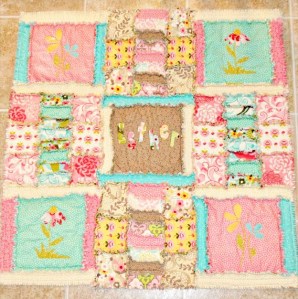







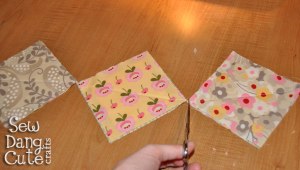
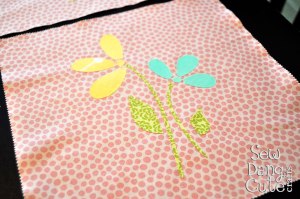



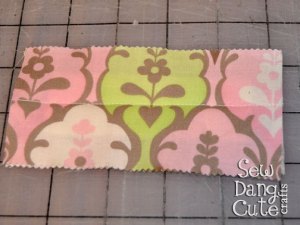
 The walking foot makes it so the fabric is fed through evenly and you avoid bunching – great for when you are working with numerous layers of fabric!
The walking foot makes it so the fabric is fed through evenly and you avoid bunching – great for when you are working with numerous layers of fabric! 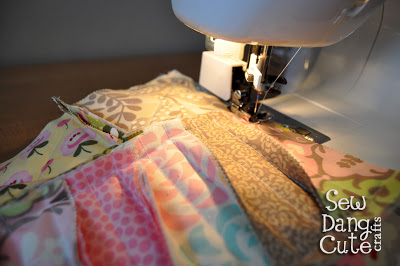 Grab three of your (B) squares. *Note: You can do a larger or smaller seam, depending how much fringe you want. I chose to do a 1/2″ seam for this rag quilt. Using 1/2″ seams, sew the back sides of the quilt together, so the seam is sticking out on the top side of the quilt.
Grab three of your (B) squares. *Note: You can do a larger or smaller seam, depending how much fringe you want. I chose to do a 1/2″ seam for this rag quilt. Using 1/2″ seams, sew the back sides of the quilt together, so the seam is sticking out on the top side of the quilt. 





